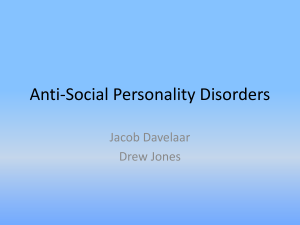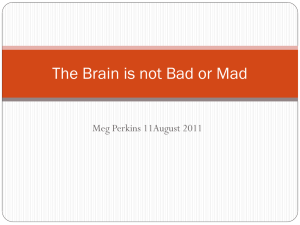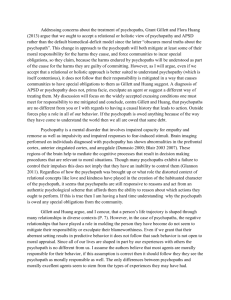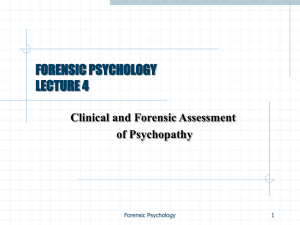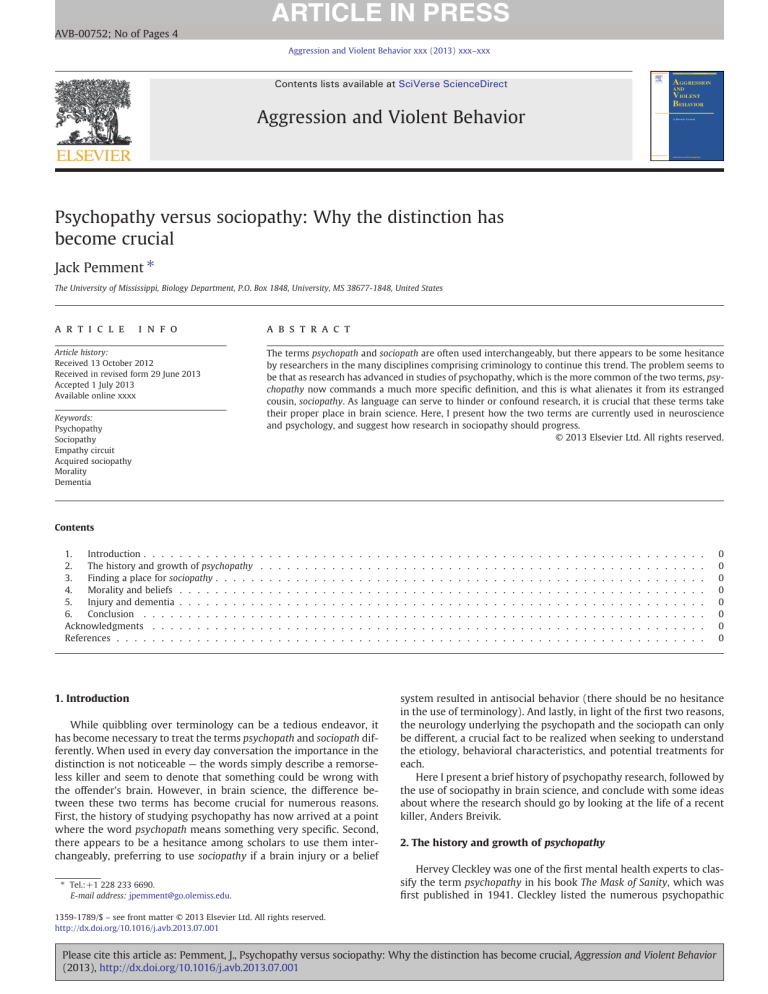
AVB-00752; No of Pages 4
Aggression and Violent Behavior xxx (2013) xxx–xxx
Contents lists available at SciVerse ScienceDirect
Aggression and Violent Behavior
Psychopathy versus sociopathy: Why the distinction has
become crucial
Jack Pemment ⁎
The University of Mississippi, Biology Department, P.O. Box 1848, University, MS 38677-1848, United States
a r t i c l e
i n f o
a b s t r a c t
Article history:
Received 13 October 2012
Received in revised form 29 June 2013
Accepted 1 July 2013
Available online xxxx
The terms psychopath and sociopath are often used interchangeably, but there appears to be some hesitance
by researchers in the many disciplines comprising criminology to continue this trend. The problem seems to
be that as research has advanced in studies of psychopathy, which is the more common of the two terms, psychopathy now commands a much more specific definition, and this is what alienates it from its estranged
cousin, sociopathy. As language can serve to hinder or confound research, it is crucial that these terms take
their proper place in brain science. Here, I present how the two terms are currently used in neuroscience
and psychology, and suggest how research in sociopathy should progress.
© 2013 Elsevier Ltd. All rights reserved.
Keywords:
Psychopathy
Sociopathy
Empathy circuit
Acquired sociopathy
Morality
Dementia
Contents
1.
Introduction . . . . . . . . . . . . .
2.
The history and growth of psychopathy
3.
Finding a place for sociopathy . . . . .
4.
Morality and beliefs . . . . . . . . .
5.
Injury and dementia . . . . . . . . .
6.
Conclusion . . . . . . . . . . . . .
Acknowledgments . . . . . . . . . . . .
References . . . . . . . . . . . . . . . .
.
.
.
.
.
.
.
.
.
.
.
.
.
.
.
.
.
.
.
.
.
.
.
.
.
.
.
.
.
.
.
.
.
.
.
.
.
.
.
.
.
.
.
.
.
.
.
.
.
.
.
.
.
.
.
.
.
.
.
.
.
.
.
.
.
.
.
.
.
.
.
.
.
.
.
.
.
.
.
.
.
.
.
.
.
.
.
.
.
.
.
.
.
.
.
.
.
.
.
.
.
.
.
.
.
.
.
.
.
.
.
.
1. Introduction
While quibbling over terminology can be a tedious endeavor, it
has become necessary to treat the terms psychopath and sociopath differently. When used in every day conversation the importance in the
distinction is not noticeable — the words simply describe a remorseless killer and seem to denote that something could be wrong with
the offender's brain. However, in brain science, the difference between these two terms has become crucial for numerous reasons.
First, the history of studying psychopathy has now arrived at a point
where the word psychopath means something very specific. Second,
there appears to be a hesitance among scholars to use them interchangeably, preferring to use sociopathy if a brain injury or a belief
⁎ Tel.:+1 228 233 6690.
E-mail address: jpemment@go.olemiss.edu.
.
.
.
.
.
.
.
.
.
.
.
.
.
.
.
.
.
.
.
.
.
.
.
.
.
.
.
.
.
.
.
.
.
.
.
.
.
.
.
.
.
.
.
.
.
.
.
.
.
.
.
.
.
.
.
.
.
.
.
.
.
.
.
.
.
.
.
.
.
.
.
.
.
.
.
.
.
.
.
.
.
.
.
.
.
.
.
.
.
.
.
.
.
.
.
.
.
.
.
.
.
.
.
.
.
.
.
.
.
.
.
.
.
.
.
.
.
.
.
.
.
.
.
.
.
.
.
.
.
.
.
.
.
.
.
.
.
.
.
.
.
.
.
.
.
.
.
.
.
.
.
.
.
.
.
.
.
.
.
.
.
.
.
.
.
.
.
.
.
.
.
.
.
.
.
.
.
.
.
.
.
.
.
.
.
.
.
.
.
.
.
.
.
.
.
.
.
.
.
.
.
.
.
.
.
.
.
.
.
.
.
.
.
.
.
.
.
.
.
.
.
.
.
.
.
.
.
.
.
.
.
.
.
.
.
.
.
.
.
.
.
.
.
.
.
.
.
.
.
.
.
.
.
.
.
.
.
.
.
.
.
.
.
.
.
.
.
.
.
.
.
.
.
.
.
.
.
.
.
.
.
.
.
.
.
.
.
.
0
0
0
0
0
0
0
0
system resulted in antisocial behavior (there should be no hesitance
in the use of terminology). And lastly, in light of the first two reasons,
the neurology underlying the psychopath and the sociopath can only
be different, a crucial fact to be realized when seeking to understand
the etiology, behavioral characteristics, and potential treatments for
each.
Here I present a brief history of psychopathy research, followed by
the use of sociopathy in brain science, and conclude with some ideas
about where the research should go by looking at the life of a recent
killer, Anders Breivik.
2. The history and growth of psychopathy
Hervey Cleckley was one of the first mental health experts to classify the term psychopathy in his book The Mask of Sanity, which was
first published in 1941. Cleckley listed the numerous psychopathic
1359-1789/$ – see front matter © 2013 Elsevier Ltd. All rights reserved.
http://dx.doi.org/10.1016/j.avb.2013.07.001
Please cite this article as: Pemment, J., Psychopathy versus sociopathy: Why the distinction has become crucial, Aggression and Violent Behavior
(2013), http://dx.doi.org/10.1016/j.avb.2013.07.001
2
J. Pemment / Aggression and Violent Behavior xxx (2013) xxx–xxx
traits with which we have all become familiar, such as superficial
charm, lack of remorse, and an impersonal sex life (Ogloff, 2006).
However, the next significant breakthrough came from Robert Hare,
a Canadian psychologist who devised the Psychopathy Checklist
(PCL-R) (Hare, 1991). The PCL-R is used in many studies exploring
the behavior and neurology of psychopathic individuals as it is often
one of the key criteria for separating psychopathic from the nonpsychopathic individuals (Basoglu et al., 2011; Craig et al., 2009;
Raine et al., 2004; Vaidyanathan, Hall, Patrick, & Bernat, 2011; Yang,
Raine, Colletti, Toga, & Narr, 2010).
In recent years, the PCL-R has met with some controversy. Hare
has expressed a preference that the test only be used in an academic
setting, rather than in a court room, as there have been cases where
mental health experts hired by the defense and by the prosecution
come up with suspiciously different results for the defendant.1
However, the brilliance of the PCL-R should not be undermined.
Hare designed the test from a strictly behavioral point of view and managed to list all relevant behaviors of the psychopath and create a scoring
system that could tell you if the person was psychopathic or not. Hare
has always stressed that in order to identify these behaviors, and to
deal with the pathological lying of the psychopath, the test needs to
be administered by a trained professional. When the test was first
designed, Hare could not have known of the immense screening
power the test would have for neuroscientists a decade later.
By using the PCL-R (or the abbreviated PCL-SV) as a screening tool,
it was possible to find that psychopaths have reduced gray matter in
their frontal lobes (Muller et al., 2008; Raine, Lencz, Birhle, LaCasse, &
Colletti, 2000; Yang et al., 2010), increased striatal volume (Glenn,
Raine, Yaralian, & Yang, 2010), abnormal asymmetry in the hippocampus (Laakso et al., 2001; Raine et al., 2004), a larger corpus
callosum (Raine et al., 2003), a lack of structural integrity in the uncinate fasciculus2 (Craig et al., 2009), abnormal activity in the anterior
cingulate cortex (ACC) (Kiehl et al., 2001), and deformations within
the amygdala (Yang, Raine, Colletti, & Toga, 2009). There are two
points to note here; first, the PCL-R works extremely well as the
differences in neurology reflect the results of the test (at least in an academic setting). Second, all of these neurological studies have added an
immense amount of knowledge to what it means biologically to be a
psychopath.
A number of the neurological differences mentioned above are
associated with interruptions to their respective developmental pathways in early life. Raine et al. (2003) point out that the corpus
callosum starts out larger in childhood but “trims back” as the brain
develops; and Raine et al. (2004) state that the kind of asymmetry noticed in the hippocampi in psychopaths reflects the asymmetry seen
in the fetus — an asymmetry which diminishes throughout the development of the child. So, is something happening to children in their
early lives that could end up orchestrating the construction of the
psychopath brain? Farrington (2005) explains that antisocial behavior in children appears to be correlated with physical abuse, parental
conflict, and antisocial parents (among a number of other factors),
and it would not surprise anyone if this extremely stressful home
life stunted the child's brain from developing normally.
There have also been many studies on the autonomic functioning of
psychopaths, some of which preceded the advent of the PCL-R. Hare
(1968) summarizes many of the studies before 1968, and concludes
through his own investigation that autonomic functioning in the psychopath does appear to be slightly different from the non-psychopath
while at rest, as demonstrated by a lower level of skin conductance
and lower heart rate variability. Later studies have also found reduced
1
Dr. Hare expresses his concern over the use of the PCL-R in the legal system on NPR.
http://www.npr.org/2011/05/27/136723357/creator-of-psychopathy-test-worries-aboutits-use
2
The uncinate fasciculus is the white matter tract that allows communication between the frontal cortex and the limbic structures, particularly the amygdala.
physiological changes when psychopaths are presented with fear imagery (Levenston, Patrick, Bradley, & Lang, 2000; Patrick, Cuthbert, & Lang,
1994). These physiological differences in the psychopath have prompted
many to wonder if these response deficits are why psychopaths appear
affectively blind and do not have an in depth understanding of emotions.
Gao, Raine, and Schug (2012) suggest that psychopaths are genuinely
unable to appreciate their own body sensations; therefore, the pathological lying dimension to psychopathic behavior does not extend to understanding their own emotional experiences.
Hopefully, I have shown that the term psychopath means a great
deal to those in brain science. And it is precisely because of this rich
history in psychopath research that having another term can only
serve to confound our understanding of this dangerous condition.
3. Finding a place for sociopathy
Hare and Babiek (2006) acknowledge a clear difference between
psychopathy and sociopathy. Psychopathy, which is the condition Hare
successfully captured with the PCL-R, means the individual will have
no empathy or sense of morality among a number of other traits
(Hare, 1991). Sociopathy, on the other hand, is indicative of having a
sense of morality and a well-developed conscience, but the sense of
right and wrong is not that of the parent culture. As this difference is
reflected in the brain, the distinction again shows its use.
4. Morality and beliefs
To help give sociopathy its own neurological correlate, a study of
the empathy circuit (Baron-Cohen, 2011) is useful. The empathy circuit, proposed by Baron-Cohen (2011), consists of 10 regions, all
with an arguable role in empathy; as empathy represents our capacity
to understand another's emotional disposition, it allows neuroscience
to stake a claim in discussions of morality. Not surprisingly, some of
the regions mentioned are areas that failed to develop in the psychopath; these regions include certain areas of the frontal cortex, the
ACC, and the amygdala. Consequently, here we see that psychopaths,
who have no sense of morality, have compromised areas in the empathy circuit. If sociopaths do have a sense of morality, then it would be
crucial to know how their brain compares to psychopaths.
The fact that sociopaths do have a sense of morality and a sense of
right and wrong reflects that they have beliefs about the social world.
There are some regions in the empathy circuit (Baron-Cohen, 2011)
that are affected by our beliefs and their impact on the rest of the
brain is not necessarily hindered by injury or dementia. The ACC is
known for its involvement in pain recognition in ourselves (Lane et al.,
1998), and activity in this region has been correlated with whether we
think punitive actions against others are just or unjust (Singer et al.,
2006). Singer et al. (2006), using functional magnetic resonance imaging
(fMRI), found that the activity in the ACC decreases when people believe
that the punishment another person receives is considered fair; this was
particularly true of the male participants. While neurodevelopmental
differences between the male and female ACC could facilitate this difference in judgment, deciding on whether a punishment is just or fair is a
reflection of beliefs. If beliefs can cause a variance of activation in any
part of the empathy circuit, we can see how it might be possible for differences in belief to cause subtle neurological differences that promote
different moral behavior.
Differences in the amygdala have also been correlated with a difference in worldviews. Kanai, Feilden, Firth, and Rees (2011) found
that the right amygdala in conservatives was larger than in liberals.
While interpreting this result remains a challenge, it is nevertheless
a neurological difference that reflects a worldview and a different
moral outlook. Clearly, further studies need to examine if the worldview resulted in this neurological difference, or if the neurological
difference occurred independently of any worldview, but favored
acquisition of the worldview — or if they at some point began to
Please cite this article as: Pemment, J., Psychopathy versus sociopathy: Why the distinction has become crucial, Aggression and Violent Behavior
(2013), http://dx.doi.org/10.1016/j.avb.2013.07.001
J. Pemment / Aggression and Violent Behavior xxx (2013) xxx–xxx
perpetuate one another. Whatever the result, however, an enlarged
right amygdala is indicative of a conservative morality, and demonstrates that beliefs could either result in a change to this part of the
empathy circuit, or certain kinds of beliefs will be perpetuated as a result of this change to this part of the empathy circuit.
In order to develop a sense of morality in the first instance, it
seems crucial that certain areas in the prefrontal cortex are at least
partly functional. For example, Amodio and Frith (2006) explain the
importance of the anterior region of the rostral medial frontal cortex
(arMFC); it is needed for mentalizing (thinking about the intentions,
desires, and beliefs of others), self-knowledge (distinguishing yourself from others), and person knowledge (being aware of the perception and judgments of others). These three important methods of
social reflection seem pivotal in establishing a sense of morality because they are how we understand the behaviors of others and determine whether or not we like this behavior, which we can measure
against how we choose to behave based upon self-reflection, our
awareness of others, and our own beliefs. Sociopathy, unlike psychopathy, therefore, requires a higher degree of neuronal integrity
in the medial prefrontal cortex.
To summarize, there are neurological correlates for how beliefs
could promote specific kinds of attitudinal or behavioral moral outcomes. These correlates provide a basis for studying how beliefs create our moral identity by affecting our empathy circuit. However, a
large component of sociopathy involves antisocial behavior, and I
am unaware of any neurological study that ties beliefs to antisocial
behavior.
3
The trouble with this study is that the behaviors are not unique to any
kind of neurology, after all, the patients had a range of different dementias. Examples cited in the study include a man with Huntington's
Disease who stalked his ex-wife and threatened to kill her (he had
mild cortical atrophy and hypometabolism bilaterally in the caudate
and putamen), a man diagnosed with Alzheimer's Disease who
threatened individuals he believed were trying to steal his belongings, and a man with subacute dementia who could not stop from
making inappropriate comments or inappropriately touching others.
In these instances, acquired sociopathy appears to be an umbrella
term for antisocial behavior resulting from a range of dementias. If
this is to remain a definition for sociopathy it will be as useless to
mental health experts as the term insane.
Another point to make about Mendez et al. (2011) is that many
who develop sociopathic behavior from dementia are likely to be
over the age of 40; Alzheimer's Disease is typically diagnosed around
age 65, although sometimes the individual can be as young as 30,3
and Huntington's Disease, despite rare occurrences of it appearing
in childhood or adolescence, typically appears in those in their 30s
and over.4 The usual onset of dementia does not fit in well with the
age–crime curve (a curve that shows the likelihood of people of different ages committing a crime), which peaks in the late teens
(Loeber & Stallings, 2011). This means that sociopathy is extremely
unlikely to be prevalent in young offenders, unlike psychopathy
which can be diagnosed in the form of extreme antisocial personality
disorder at age 18. This diminishes the utility of using sociopathy in
criminology, especially since many with dementia do not develop sociopathic behavior.
5. Injury and dementia
6. Conclusion
Numerous physicians and neuroscientists refer to sociopathy in
terms of acquired sociopathy (Barrash, Tranel, & Anderson, 2000;
Blair & Cipolotti, 2000; Mendez, Chen, Shapira, & Miller, 2005),
which is usually when a brain injury or dementia in the frontal
lobe(s) results in antisocial behavior. It must be noted here that this
definition of sociopathy is vastly different from the one offered by
Hare and Babiek (2006). Perhaps the most famous story of acquired
sociopathy is the case of Phineas Gage; Gage, who worked on the railroad in the nineteenth century, received a metal spike through his
frontal lobe as the result of an explosion (Mendez, Shapira, & Saul,
2011). A closer analysis of the accident has led some to believe that
the rod pierced through Gage's ventromedial prefrontal cortex
(VMPFC) (Damasio, Grabowski, Frank, Galaburda, & Damasio, 1994).
Gage apparently went from being a responsible worker to irresponsible, profane, and indifferent to the social conventions of his time
(Sanfey, Hastie, Colvin, & Grafman, 2003). It is worth asking if Gage
still had a sense of morality, but it is this kind of personality change
caused by damage to the frontal lobe that defines acquired sociopathy.
The first person to use the term acquired sociopathy was Antonio
Damasio after his lengthy examinations of the patient, E. V. R., who
had lesions to the orbitofrontal cortex and subsequently changed from
being a happily married professional to being divorced numerous
times with a failed business (Blair & Cipolotti, 2000). The resultant personality changes that led patients to exhibit a lack of concern for others
and a lack of remorse led Damasio to suggest that psychopathy could be
the developmental counterpart to this acquired sociopathy (Blair &
Cipolotti, 2000). This seems a little overly ambitious, as an abnormal
frontal lobe is only one piece of the psychopathy puzzle — as we have
seen, differences can also arise in the amygdala, hippocampus, corpus
callosum, striatum, and the uncinate fasciculus, although there is little
doubt that damage to the frontal lobe can easily result in antisocial behavior (Brower & Price, 2001; Kandel & Freed, 1989).
Mendez et al. (2011) examined acquired sociopathy in dementia
patients. The study involved 33 dementia patients, but the criteria
for sociopathy included a range of behavior that included physical assault, theft, indecent exposure, and stalking with homicidal behavior.
I have presented three reasons why psychopathy cannot be treated
the same way as sociopathy. First, psychopathy research has been so
rich and deep that the term has taken on a tremendous amount of
meaning, partly because psychopathy is a developmental disorder
that is associated with specific kinds of behavior. Second, if we use
the definition that sociopaths have a sense of morality, we have to
allow for brain differences that are not present in the psychopath.
And last, acquired sociopathy, which is very different from psychopathy, seems to be satisfied by the mere presence of antisocial behavior
brought about by lesions, from both trauma and surgery, or dementia.
Providing sociopathy with its own distinct and useful meaning, I
think, has to come from the second reason, which could provide a
neurological correlate to the definition supplied by Hare and Babiek
(2006). Discovering how beliefs affect the brain and our moral judgment is crucial research; however, how ideas can cause physiological
changes in the brain is certainly not as obvious as finding damage or
abnormalities. If we can expand on the studies that already exist, we
can see how the beliefs of a subculture provide a morality and a
worldview that could permit the individual to indulge in heinous
acts such as mass killing.
I would like to contend that this new approach for understanding
sociopathy would allow us to understand individuals such as Anders
Breivik, the Norwegian gunman who on the 22nd July, 2011, murdered 77 people; 8 from a car bomb in Oslo, and 69 who he shot at
a summer camp on the island of Utoeya.5 Breivik had written a
1801 page manifesto and was very steeped in his own version of national socialism.6 He saw his place in the world as a crusader and a
martyr for his cause, and consequently his acts were necessary.
3
Alzheimer's Association: http://www.alz.org/downloads/facts_figures_2012.pdf
National Institute for Health, Genetics Home Reference: http://ghr.nlm.nih.gov/
condition/huntington-disease
5
BBC Article: Anders Breivik pleads not guilty at murder trial. http://www.bbc.co.
uk/news/world-europe-17724535
6
Guardian, Anders Behring Breivik attacks inspired by Serbian nationalists, Helen Pidd.
http://www.guardian.co.uk/world/2012/apr/18/anders-behring-breivik-serb-nationalists
4
Please cite this article as: Pemment, J., Psychopathy versus sociopathy: Why the distinction has become crucial, Aggression and Violent Behavior
(2013), http://dx.doi.org/10.1016/j.avb.2013.07.001
4
J. Pemment / Aggression and Violent Behavior xxx (2013) xxx–xxx
When he opened fire at the many children in the camp was there limited
activity in his ACC? And, if so, how long had his ACC promoted this outlook? Breivik had a sense of right and wrong that clearly differed from
the morality of the parent culture and he killed remorselessly.
The key to understanding sociopathy has to be in the power that
ideas exert on the brain.
Acknowledgments
I would like to thank Derek and Sally Pemment for inspiring me all
of these years and providing me with unlimited and unconditional
love and support.
References
Amodio, D., & Frith, C. (2006). Meeting of minds: The medial frontal cortex and social
cognition. Nature Reviews. Neuroscience, 7, 268–277.
Baron-Cohen, S. (2011). The science of evil. Philadelphia: Basic Books.
Barrash, J., Tranel, D., & Anderson, S. (2000). Acquired personality disturbances associated with bilateral damage to the ventromedial prefrontal region. Developmental
Neuropsychology, 18(3), 355–381.
Basoglu, C., Oner, O., Ates, A., Algul, A., Bez, Y., Cetin, M., Herken, H., Erdal, M. E., & Munir,
K. M. (2011). Synaptosomal-associated protein 25 gene polymorphisms and antisocial personality disorder: Association with temperament and psychopathy. Canadian
Journal of Psychiatry, Revue canadienne de psychiatrie, 56(6), 341–347.
Blair, R., & Cipolotti, L. (2000). Impaired social response reversal: A case of ‘acquired
sociopathy’. Brain, 123(6), 1122–1141.
Brower, M., & Price, B. (2001). Neuropsychiatry of frontal lobe dysfunction in violent
and criminal behavior: A critical review. Journal of Neurology, Neurosurgery, and
Psychiatry, 71, 720–726.
Craig, M., Catani, M., Deeley, Q., Latham, R., Daly, E., Kanaan, R., et al. (2009). Altered
connections on the road to psychopathy. Molecular Psychiatry, 14, 946–953.
Damasio, H., Grabowski, T., Frank, R., Galaburda, A., & Damasio, A. (1994). The return of
Phineas Gage: clues about the brain from the skull of a famous patient. Science,
264, 1102–1105.
Farrington, D. (2005). Childhood origins of antisocial behavior. Clinical Psychology &
Psychotherapy, 12(3), 177–190.
Gao, Y., Raine, A., & Schug, R. (2012). Somatic aphasia: Mismatch of body sensations with
autonomic stress reactivity in psychopathy. Biological Psychology, 90, 228–233.
Glenn, A., Raine, A., Yaralian, P., & Yang, Y. (2010). Increased volume of striatum in psychopathic individuals. Biological Psychiatry, 67(1), 52–58.
Hare, R. (1968). Psychopathy, autonomic functioning, and the orienting response. Journal of Abnormal Psychology, 73(3ii), 1–24.
Hare, R. D. (1991). Manual for the Hare Psychopathy Checklist — Revised. Toronto:
Multi-Health Systems.
Hare, R., & Babiek, P. (2006). Snakes in suits. New York: Harper Collins.
Kanai, R., Feilden, T., Firth, C., & Rees, G. (2011). Political orientations are correlated
with brain structure in young adults. Current Biology, 21, 677–680.
Kandel, E., & Freed, D. (1989). Frontal lobe dysfunction and antisocial behavior: A review. Journal of Clinical Psychology, 45(3), 404–413.
Kiehl, K., Smith, A., Hare, R., Mendrek, A., Forster, B., Brink, J., et al. (2001). Limbic abnormalities in affective processing by criminal psychopaths as revealed by functional magnetic resonance imaging. Biological Psychiatry, 50(9), 677–684.
Laakso, M., Vaurio, O., Koivisto, E., Savolainen, L., Eronen, M., Aronen, H., et al. (2001).
Psychopathy and the posterior hippocampus. Behavioural Brain Research, 118(2),
187–193.
Lane, R., Reiman, E., Axelrod, B., Yun, L., Holmes, A., & Schwartz, G. (1998). Neural correlates of levels of emotional awareness: Evidence of an interaction between emotion
and attention in the anterior cingulate cortex. Journal of Cognitive Neuroscience,
10(4), 525–535.
Levenston, G., Patrick, C., Bradley, M., & Lang, P. (2000). The psychopath as observer:
Emotion and attention in picture processing. Journal of Abnormal Psychology,
109(3), 373–385.
Loeber, R., & Stallings, R. (2011). Modeling the impact of interventions on local indicators
of offending, victimization, and incarceration. In Rolf Loeber, & David P. Farrington
(Eds.), Young homicide offenders and victims: Development, risk factors and prediction
from childhood (pp. 137–152). New York: Springer.
Mendez, M., Chen, A., Shapira, J., & Miller, B. (2005). Acquired sociopathy and
frontotemporal dementia. Dementia and Geriatric Cognitive Disorders, 20(2–3),
99–104.
Mendez, M. F., Shapira, J., & Saul, R. (2011). The spectrum of sociopathy in
dementia. Journal of Neuropsychiatry and Clinical Neurosciences, 23(2),
132–140.
Muller, J., Gansbauer, S., Sommer, M., Dohnel, K., Weber, T., Schmidt-Wilcke, T., et al.
(2008). Gray matter changes in right superior temporal gyrus in criminal psychopaths. Evidence from voxel-based morphometry. Psychiatry Research: Neuroimaging,
163(3), 213–222.
Ogloff, J. R. (2006). Psychopathy/antisocial personality disorder conundrum. The
Australian and New Zealand Journal of Psychiatry, 40, 519–528.
Patrick, C., Cuthbert, B., & Lang, P. (1994). Emotion in the criminal psychopath: Fear
image processing. Journal of Abnormal Psychology, 103(3), 523–534.
Raine, A., Ishikawa, S., Estibalez, A., Lencz, T., Knuth, K., Birhle, S., et al. (2004). Hippocampal structural asymmetry in unsuccessful psychopaths. Biological Psychiatry, 5,
185–191.
Raine, A., Lencz, T., Birhle, S., LaCasse, L., & Colletti, P. (2000). Reduced prefrontal gray
matter volume and reduced autonomic activity in antisocial personality disorder.
Archives of General Psychiatry, 57, 119–127.
Raine, A., Lencz, T., Taylor, K., Hellige, J., Birhle, S., Lacasse, L., et al. (2003). Corpus
callosum abnormalities in psychopathic antisocial individuals. Archives of General
Psychiatry, 60, 1134–1142.
Sanfey, A., Hastie, R., Colvin, M., & Grafman, J. (2003). Phineas gauged: Decisionmaking and the human prefrontal cortex. Neuropsychologia, 41, 1218–1229.
Singer, T., Seymour, B., O'Doherty, J., Stephen, K., Dolan, R., & Frith, C. (2006). Empathic
neural responses are modulated by the perceived fairness of others. Nature,
439(7075), 466–469.
Vaidyanathan, U., Hall, J., Patrick, C., & Bernat, E. (2011). Clarifying the role of defensive
reactivity deficits in psychopathy and antisocial personality using startle reflex
methodology. Journal of Abnormal Psychiatry, 253–258.
Yang, Y., Raine, A. N., Colletti, P., & Toga, A. (2009). Localizations of deformations within
the amygdala in individuals with psychopathy. Archives of General Psychiatry,
66(9), 986–994.
Yang, Y., Raine, A., Colletti, P., Toga, A., & Narr, K. (2010). Morphological alterations in
the prefrontal cortex and the amygdala in unsuccessful psychopaths. Journal of
Abnormal Psychology, 546–554.
Please cite this article as: Pemment, J., Psychopathy versus sociopathy: Why the distinction has become crucial, Aggression and Violent Behavior
(2013), http://dx.doi.org/10.1016/j.avb.2013.07.001


